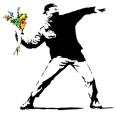
Dorothea Lange (May 26th 1895-October 11th 1965) was a famous photographer of human forms. Her works are referred to as being a documentation of an era. Her photos humanized the tragic consequences of the Great Depression as well as influenced the development of documentary photography

to what it is today. She started out as a portrait photographer having a studio in San Francisco. However once the depression began she left her studio and started paying more attention to what was happening on the streets. She spent much of her career studying the homeless, migrant workers and farmers. She was able to capture feelings of the depression through imagery of the poor and forgotten people of this time. But also in doing so, while showing hopelessness and despair she was able to also show pride and dignity of what those people endured under the circumstances. Once the second world war began she focused her attention on the relocation camps of the Japanese Americans. Many of these images were censored by the government and after seeing these events Lange did not agree with the government. She intended to bring up racial and civil right issue to the public put on by the intendment camps. Dorothea has paved away a path for photographers since her time. I am currently undecided in a career path in art. I do not know if I want to take a photography approach, however I do like using details and drawing human figures.
Dorothea Lange has made huge developments to the direction photography takes in today’s practices. She was one of the first people to be able to create a social documentary to the life they currently live in. She brought the struggle of the depression and the relocation to public attention. She even has some of her works censored by the government. In 1941 she w

on an award for excellence in photography called Guggenheim Fellowship. She has helped to capture the imagery of people’s emotions to educate the public.
I was really impressed at the level in which Lange went about in capturing the feeling of the people she encountered. Her most famous work is called Migrant Mother with three children positioned around her. She got this image from a migrant campsite and recalls her experience:"I had to get my camera to register the things that were more important than how poor they were, their pride, strength, and spir

t." Lange was very determined to capture entire feelings of people. I was also impressed by all the close details she was able to produce. In this picture the wrinkles and the gaze. Many of her images have become icons for the era.
When I think about dominance in these images I thin about the feeling or the mood that they create. That is the overall goal that the artist is trying to convey. Dominance also plays a huge role in the human figures. For example in the migrant mother the mother is in center and is the largest making her dominant. The figure to the right the body of the boy is dominant the larger hands are subordinate and the individual whit fingertips of the boy act as accentuals.
The human form is the most important visual thing for all these images .Even though she is focusing on the human figu

re, Dorothea is most concerned about expressions and capturing the feeling and mood of the individuals. She allows all her images to represent as much detail as possible in the human form. The wrinkles in the hands and the folds in the clothes are excellent examples of capturing everything about the human form.
By viewing Dorothea Lange’s work I have gained a better appreciation and understanding of photography especially because this was mostly all done before the sixties. I am more intrigued

now to draw and practicing capturing thought and feeling into visual imagery of the human form. I really enjoyed getting to see what was happening in a scene without actually being there in person. I feel like I should maybe look into taking a photography class because I am interested in the human form. Maybe this medium is where I can be most creative.
Unfortunately color was not an option when these pictures were taken. I wish however that it would have been because I would have liked to see how Dorothea would have handled it in her compositions. Even though her photos lack color I think I like them that way

. By being only in blacks and whites I get a feeling of urgency and a better sense of mood. Without color I can really concentrate all my attention in looking at details and viewing expressions. Although these images lack true color they do have variances in shades. By indicating different shades I can better view the details in all the images. By having just the blacks and the whites I get a great sense of push and pull between objects in a single image. I also get a feeling of completeness this is almost psychological and relates to the temperate of the piece. In some pictures I fell sad when looking at them where others I see conflict. So I think overall I am glade that these images never had any true sense of color outside of value, because if they had I may feel like I lost some of the closeness feeling with the pictures.






















